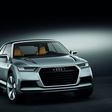You can login to your account or create a new account.
You can login to your account or create a new account.
You can login to your account or create a new account.
Audi has unveiled the crosslane coupé at the Paris Motor Show. With a Multimaterial Space Frame, the vehicle concept is a plug-in hybrid drive based on a purpose-designed 1.5-liter three-cylinder TFSI and two electric motors, with fuel consumption of 1.1 liters per 100 km (213.81 US mpg) and CO2 emissions of 26 grams per km (41.84 grams per mile).
Accoding to the manufacturer, the vehicle is supposed to appeal to young, sporty customers in particular, offering a removable roof and customizable services .
The Multimaterial Space Frame of the compact Audi crosslane coupé is comprised of aluminum, carbon fiber-reinforced polymer (CFRP), and glass fiber-reinforced polymer (GFRP). The concept car has an unladen weight of about 1,390 kg (3,064.43 lb), including the lithium-ion battery.
The plug-in hybrid drive of the Audi crosslane coupé is described as a dual-mode hybrid. It comprises a combustion engine, two electric motors and a single-stage transmission; its system power is 130 kW (177 hp). The Audi crosslane coupé sprints from zero to 100 km/h (62.14 mph) in 8.6 seconds, and in pure electric mode takes 9.8 seconds. The car’s top speed is 182 km/h (113.09 mph). Its average fuel consumption is 1.1 liters per 100 km (213.81 US mpg) and it emits 26 grams per km (41.84 grams per mile) of CO2. The lithium-ion battery has an output of 17.4 kWh, sufficient for an operating range of around 86 km (53.44 miles) in the electric mode.
The combustion engine is a three-cylinder TFSI with a displacement of 1.5 liters, delivering an output of 95 kW (130 hp) and 200 Nm (147.51 lb-ft) of torque. The three-cylinder engine is coupled to an electric motor (EM 1), which acts primarily as a starter and an alternator. It develops an output of 50 kW (68 hp) and 210 Nm (154.89 lb-ft) of torque. Electrical traction is provided by the second electric motor (EM 2) developing 85 kW (116 hp) and 250 Nm (184.39 lb-ft) of torque. The transmission makes it possible to connect the combustion engine complete with alternator to the remainder of the drivetrain by means of a claw clutch.
The dual-mode hybrid concept enables different operating modes. From 0 up to 55 km/h (34.18 mph), drive power is supplied solely by the EM 2, which draws the energy it needs primarily from the battery. In serial mode, the combustion engine and the alternator (EM 1) produce electrical energy to support, relieve or substitute the battery should it be discharged.
The electric mode is possible up to 130 km/h (80.78 mph). Starting at about 55 km/h (34.18 mph) the drive system allows the TFSI engine together with the alternator to couple to the drivetrain – in this hybrid mode, the drive sources combine to optimize both efficiency and performance. Above 130 km/h (80.78 mph), the three-cylinder engine becomes the main drive source but the EM 1 can support it if required.
The driver of the Audi crosslane coupé can choose between the “cruise” and “race” settings. The “cruise” mode prioritizes electric driving. The driver does not notice either gear changes or the power source kicking in. When the TFSI is running, its engine speed is always adapted to the road speed – without a “rubber-band” effect.
The 2+2-seater Audi crosslane coupé is 4.21 meters long (13.81 ft), 1.88 meters wide (6.17 ft) and 1.51 meters high (4.95 ft), with a wheelbase of 2.56 meters (8.40 ft). Its body design already provides a foretaste of the design language of a future generation of Audi Q models.
Audi
Audi’s history starts when founder August Horch opened a car company named A. Horch & Cie. in 1899. Then in 1901 his factory completed the assembly of the first Horch automobile. August Horch, however, ended up being expelled from his own company in 1909. He subsequently went on to start another car company in Zwickau, Germany, where he kept producing cars under the ‘Horch’ brandname, even though his f... more




